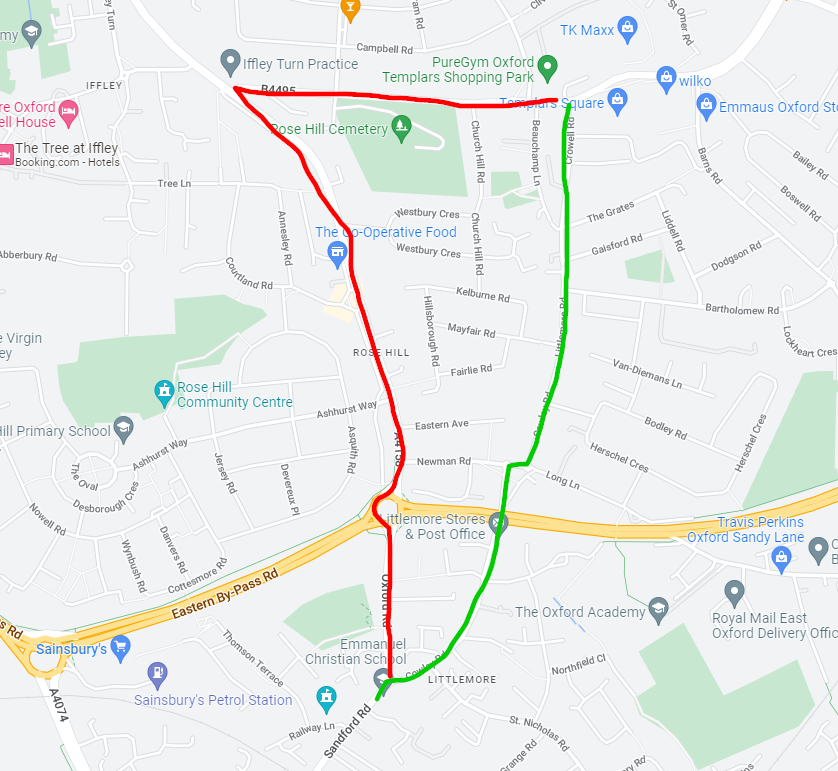Why Littlemore Road is a crucial traffic filter
One of the main criticisms of the Church Cowley LTN is that the Littlemore Road traffic filter has ‘cut-off’ Littlemore residents from Cowley, specifically the Templars Square and John Allen shopping areas. This article investigates why the Littlemore Road filter is crucial to creating a key Active Travel corridor for Oxford.
Providing a viable low-traffic cycle route from the city centre to the Leys opens up all of Littlemore South, Blackbird Leys and Greater Leys (and possibly in future the new housing south of Grenoble Road, if that gets approved) for Active Travel. This route is what the council have taken to calling a ‘Quietway’, a route for young, less time poor, or less experienced cyclists to use over the proposed ‘Quickways’.
Apart from active commuting, the Littlemore Road filter helps to facilitate a safer active school run to CCSJ Primary School, Oxford Academy, Littlemore Rugby Football Club, John Henry Newman Academy, a safer active leisure run to Kassam, Leys pool, Herschel Crescent recreation ground, a less congested bus route (allowing more frequent running), and easy active access to Royal Mail sorting office (a 6 minute ride or a 15 minute walk from Florence Park). Longer term if there is ever a Cowley branch line station a low-traffic Littlemore Road will support multi-mode transport (people walking, cycling, scootering, bussing to/from the train station).
It’s about providing the low traffic route that connects the neighborhoods along the route, not just connecting the end points i.e. Littlemore/Blackbird Leys/Greater Leys to the city centre.
The cycle path from Newman Road then along Abingdon Road/the river is great for connecting those areas (and is probably the best route for Science Park commuting), but does not pass through the residential Cowley/St.Mary’s residential areas, so people living there can’t easily use active travel to get to the Leys, and people living in the Leys can’t easily use active travel to get to Cowley/St. Marys (for work or leisure).
No less than FIVE roads – Abingdon Road, Rose Hill/Iffley Road, Cowley/Oxford/Garsington Road, Barns Road, Littlemore/Cowley Road all run in roughly the same direction (SE/NW) to roughly the same part of the ring road (representing about a sixth of the circumference of the city). The LTN scheme requires that just one of those roads is made a low traffic route to facilitate active travel for less experienced cyclists.

The remaining main driving route from Littlemore to the Cowley shopping area (the A4158 Rose Hill road and Church Cowley Road) is not “a much more complicated and daunting route”, as has been suggested. It’s 650 metres longer (1.3 miles vs 0.9 miles), and involves some traffic lights and a roundabout. It’s still in your own car, and there is still ample parking once you get there. It’s via main roads with a speed camera, that doesn’t pass primary schools.

If we have somehow arrived at a society where we must always maintain the most convenient existing driving route possible in order to not disenfranchise anyone, then we have gone seriously wrong somewhere. Life may be tough for a lot of people for a number of reasons, but asking them to drive a slightly longer route, in order to even-out the imbalance between private motor car use and active travel, is fundamentally reasonable.
The Cowley shopping area is scheduled for significant development, and the impact of this regeneration could well be far greater for local people than the route in which they use to get there, including the plans to slash the parking provision.
If the Littlemore Road filter is removed, this will have a direct impact on long-term health consequences for Littlemore, Blackbird Leys and Greater Leys residents. Is it fair to give Florence Park and Temple Cowley their LTNs, and leave these other neighborhoods behind? The whole country is brewing a huge public health crisis due to chronic inactivity, which is particularly acute in more deprived areas. We need more public health interventions like LTNs that support ‘building-in’ more activity into everyday life. If Littlemore Road does not remain filtered, the inactivity problems already experienced in the most outer city suburbs would just be exacerbated.
